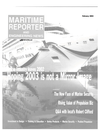
Page 16: of Maritime Reporter Magazine (February 2003)
Read this page in Pdf, Flash or Html5 edition of February 2003 Maritime Reporter Magazine
Government Update rity measures necessary to deter to the maximum extent practicable a trans- portation security incident, or a substan- tial threat of such a security incident.
Rulemakings under the MTSA are exempted from the usual provisions of the Administrative Procedures Act,
Boll Filter Corporation www.bollfilter.com including the requirement for notice and public comment. The interim regula- tions are to be issued as soon as practi- cable, except that regulations establish- ing the security incident response plan are to be promulgated before April 1, 2003. Interim regulations are to be
Circle 244 on Reader Service Card
Circle 281 on Reader Service Card superseded by final regulations (presum- ably developed in accordance with the
Administrative Procedures Act) no later than November 25, 2003.
Cost of Compliance
The Coast Guard estimates that it will
East Granby, CT 800-910-2655 boll @ bollfilterusa.com cost the average SOLAS freight ship $25,900 in the first year to comply with the vessel security requirements, with subsequent years costing $l 1,949 each.
The average SOLAS tanker would incur costs of $17,700 the first year and $11,539 annually in subsequent years.
For the average SOLAS towboat, the costs would be $4,900 and $199 the first and subsequent years respectively. For a
SOLAS cruise vessel, the added costs are estimated at $11,800 the first year and $13,204 in subsequent years.
The Coast Guard has estimated the cost for compliance by the U.S. fleet to be approximately $188 million in the first year and $144 million for each sub- sequent year. The ten-year cost of the vessel security program is estimated to cost the U.S. fleet $1.1 billion (present value). For some reason, known only to the agency, the Coast Guard did not pub- lish an estimate for the cost of compli- ance by foreign vessels (either individu- ally or in the aggregate). We should assume that, for the most part, the cost of compliance by a U.S. vessel operating under SOLAS is similar to that which would be experienced by a foreign ves- sel operating under SOLAS. The Coast
Guard estimates (in other contexts) that 75 percent of the cargo vessels calling in
U.S. ports are registered in nations other than the United States. Thus, fairly sim- ple mathematics reveal that the total first year cost of compliance with the U.S. vessel security plan requirement will be approximately $752 million, with annu- al costs of $576 million in subsequent years. The total ten-year cost of the pro- gram would then be approximately $4.4 billion (present value). For comparison purposes, it should be remembered that the Coast Guard estimated the cost of compliance with its double hull rule to be $3.5 billion (present value) in 1991.
Summary
The U.S. Coast Guard has a daunting task ahead as it works to develop vessel security plan requirements in the context mandated by the MTSA. It will need assistance from the regulated communi- ty if it is to establish standards that are both consistent with the statute and workable. Due to severe time con- straints, industry must make its views known now.
The goal is to deter, to the maximum extent practicable, a transportation secu- rity incident - in other words, to harden the target. Success consists in institut- ing the appropriate mix of security measures to deter the terrorists without either bringing commerce to a halt or bankrupting the players. This is a deli- cate balance indeed.
Bringing LNG into port...
Design, Ships, and, most of all, People
MarineSafety International participates in current LNG projects in the U.S. Why? Because we have the know- how and the facilities. Our programs assist in all aspects of port design from pier location and channel depths to naviaid placement and entry layout. Through simulation the real-world dynamics of LNG ship handling are evaluated in all types of wind, tide and visibility. MSI simulator-based training programs allow ship captains, pilots, and tug masters to learn about the new job together and to practice their communications and the skills required for safe and efficient maneuvers.
O Hunter photography Photo of lug Diane Moran courtesy ot Moran Towing, Corp.
Newport, Rl (800)341-1353
MarineSafety operates ship and port simulation centers on the East and West coasts of the U.S.
Each center is equipped with up-to-date visual ship simulators. The simulators are linked together so that current or planned assist tugs are operated by tug masters and are interactive with the piloted ship. The ship and tugs operate in the simulated, but very realistic environment of existing or planned ports.
MarineSafety has the required mix of software engineers and mariners needed to accomplish every aspect of LNG port design evaluation and operational training. Choose the preferred source for help with your LNG project. www.marinesafety.com
Norfolk, VA (757) 423-2320
MarineSafety
International
San Diego, CA (619) 231-3333 w
CvUfcate No. 36478
The Blue Ribbon Filters
BOLLFILTER
Protection Systems
For over 50 years, BOLLFILTERS have improved the efficiency and prolonged the life of ships' vital equipment throughout the world. 16 Maritime Reporter & Engineering News

 15
15

 17
17
